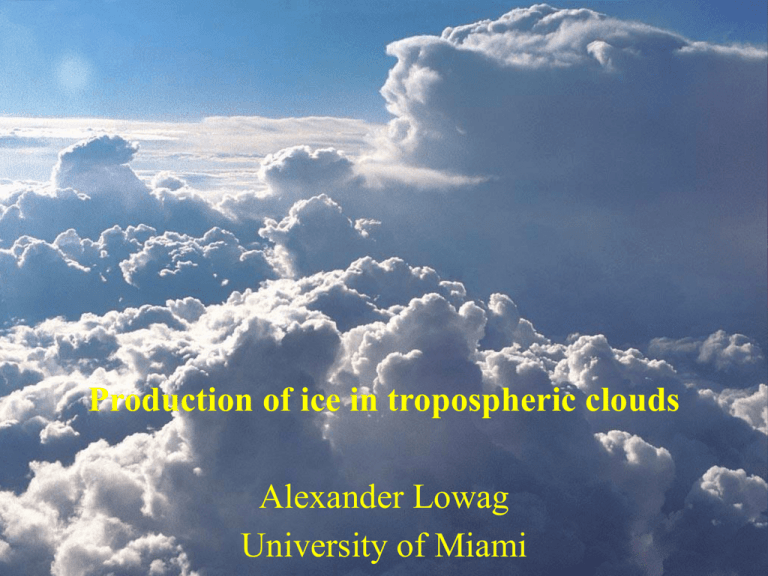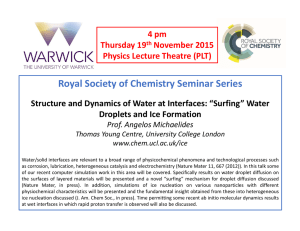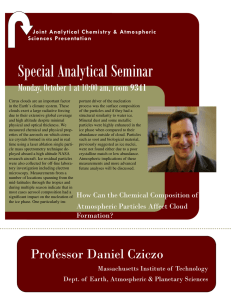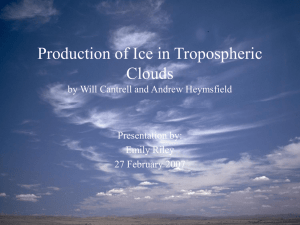Production of ice in tropospheric clouds Alexander Lowag University of Miami
advertisement

Production of ice in tropospheric clouds Alexander Lowag University of Miami Motivation: - ice: influence on various atmospheric processes, including: + precipitation + cloud electrification + radiative transfer - liquid phase: number + chemical composition of aerosols --> number of cloud droplets - solid phase: physical / chemical principles of nucleation poorly understood - secondary mechanisms: enhancement of ice concentration (number / mass) , mechanism not completely known - homogeneous nucleation: proceeds from a random event in the pure liquid or solution without catalysis from foreign substance - classical nucleation theory: energy barrier can be calculated under the assumption that microscopic ice fragment forms in supercooled liquid - nucleation rate: J = A * exp (-∆E / kT) - calculated rates in contradiction with measured ones (water droplets at – 40º C) - where is the mistake? tenet of theory? inputs to it? - to calculate ∆E, density, viscosity, specific and latent heat and surface tension must be known - Pruppacher (1995): singularity of water at -45º C, extrapolation of data aquired above 0º C However: liquid water at -70º C (Bartell and Huang, 1994) - Jeffrey and Austin (1997): analytic equation for state of water to obtain ∆E - homogeneous nucleation in Cu and Ci despite soluble aerosol particles - solute depresses melting and freezing point of ice - modified temperature to obtain nucleation rate: T' = T + µ * dT - Koop et al. (2002): nucleation rate only depends on water activity, not on solute -> Moehler et al. (2003) : freezing rate of sulfuric acid droplets -> but: spread in empirically determined µ outside experimental error margins (DeMott, 2002) - classical nucleation theory based on assumptions that may prove to limit its usefulness: + fragment initiating nucleation forms in the bulk liquid However: nucleation rate should be proportional to volume of liquid and not to how it is dispersed + embryo has same properties as bulk crystal (liquid to hexagonal ice without intermediate stage) However: nanometer-sized droplets at -70º C have cubic structure - cubic structure not stable -> consequences for ice in atmosphere - heterogeneous nucleation: freezing occurs via catalysis by a foreign body (T > -33º C) - typical aerosols: mineral dust, emissions from aircraft (soot) - equation for previous nucleation rate still applies, but ∆E is lower due to substrate - substrate forms a template on which water molecules adsorb in a configuration similar to the crystaline structure of ice - influence on radiative properties of Ci - dominating nucleators: mineral dust, fly ash, metallic particles - Zuberi et al. (2002): investigation of kaolinite and montmorillonite -> freezing points of droplets with immersed dust 10 º C higher - Hung et al. (2003): hematite and corundum aerosols in ammonium sulfate solution -> freezing point increased by 6º C - De Mott et al. (1999): investigation of ice-forming activity of black carbon particles -> untreated particles acted as deposition / absorption nuclei for T < -42º C -> activation characteristics of treated particles were similar to that of untreated ones -> multiple layers: as well as or even better than untreated particles - Soot: - surface character can have significant impact on its ice-nucleating efficiency -> chemical groups capable of forming hydrogen bonds increasing ice-forming potential -> particles with OH and carbonyl groups three orders of magnitude more efficient than those without - morphology of particle also important: “liquid” water down to -73º C - films of high-molecular-weight organic compounds -> long-chain alcohols, testosterone -> formation of a 2D hexagonal-like crystal at the air-water interface Memory effect (Preactivation): - increase in effective freezing temperature, lost if temperature exceeds some threshold typically close to melting temperature - Seeley and Seidler (2001): -> long-chain alcohols exhibit preactivation -> ice formation / cooling below melting temperature not required, i.e. layer already present at room temperature Rosinski (1991): nucleation and evaporation of droplets -> ice crystals due to deposition - deactivation of ice nuclei: loss of ice-nucleating ability after sublimation of ice Contact nucleation: freezing of a droplet initiated by contact with an aerosol particle - many substances have different freezing thresholds as a contact nuclei compared to being a condensation or immersion nuclei -> different freezing mechanisms for different modes - Seeley and Seidler (2001): examination of freezing characteristics of volcanic ash Secondary production: - Hallett-Mossop process: production of splinters during riming - consistent with ice concentration measured in Cu - could be varified in many cases: -> within convection in a frontal system off the coast of the UK (Hogan et al., 2002) -> in Cu in Mexico (Ovtchinnikov, 2000) -> ice concentrations higher than what could have been produced by Hallett-Mossop process Outstanding problems: - is freezing only a function of water activity? -> ammoniated compounds seem to be an exception - what is the mechanism underlying contact nucleation? - secondary production mechanisms in the presence of liquid water other than riming-splinting? “In summary, the origin of ice in cumuliform clouds remains a mystery” (Rangno and Hobbs, 1994)




